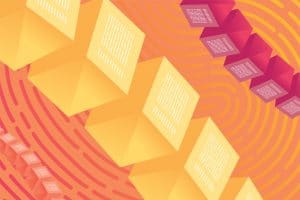Whether through the news, from excited computer-savvy friends, or over a family dinner, you may have heard of such cryptocurrencies as Bitcoin or Ethereum. These electronic financial currencies have rapidly risen from speculative digital tokens (once considered untraceable by regulators and with little intrinsic value) to tokens with quasicurrency status and an air of legitimacy. Blockchain is the underlying technology that supports cryptocurrencies. One of the reasons for Bitcoin’s success is its ingenious use of the distributed ledger—shared, synchronized data spread across multiple nodes.
Blockchain bears a resemblance to a concept that many librarians are familiar with: LOCKSS. LOCKSS (Lots of Copies Keep Stuff Safe) is a digital preservation initiative started by Stanford University Libraries in 1999. Both LOCKSS and blockchain are decentralized, distributed computing protocols that are designed to provide access to digital content and ensure its integrity.
What exactly is blockchain?
Blockchain technology links blocks of data sequentially in a distributed ledger. Each block holds a wide variety of content, including its own unique identifier, or “hash,” that identifies and links it to all blocks preceding and following it. In a traditional ledger, one might record amounts, parties involved, time of transaction, and other pertinent information. The distributed ledger takes this information, places it online, and distributes identical copies of the ledger to all the computers in the system, thereby ensuring that validated copies exist in multiple places. Once the blocks are created, they ensure that a time-stamped, immutable record of the content exists.
It is not farfetched to imagine apps that will run some background library processes.
An important component of blockchain is the use of private and public keys, an encrypted authentication mechanism that ensures the privacy of participants. Users can authenticate by making use of a private key that is only known to them. The verified authentication creates a public key, which is then associated with a transaction. The public key cannot be reverse engineered to the private key, thus ensuring privacy.
In practice, the data in the blocks can be queried and analyzed because only the public key is recorded along with each block. The amount that can be encoded in a block is limited for now. As the technology evolves, it will be possible to attach more complex data and such file formats as PDF, image, audio, video, or other file types that have not been previously associated with blockchain. This will be an important component for libraries, allowing for the preservation and authentication of digital artifacts and surrogates of physical objects (such as contracts or 3D models) to be recorded in the blockchain.
Why should libraries care?
Some initiatives in libraries are already underway, such as the work being done at the iSchool at San José (Calif.) State University, which is looking into how blockchain can help libraries. As acceptance grows, the library community will be presented with apps based on blockchain technology. Some will be developed by libraries for libraries, and others will come from commercial vendors. It is not farfetched to imagine apps that will run some background library processes, as well as forward-facing services. Perhaps blockchain will be used to secure user records in libraries, document library acquisitions, and improve collections maintenance. Applications for special collections could allow for identification and discovery of unique holdings. The scholarly record is another use case that lends itself to blockchain by allowing researchers to record and timestamp their ideas and disseminate knowledge.
Libraries have a major opportunity to use blockchain technology to advance privacy for users, increase collaboration, and transform the way they work with each other and their communities. By keeping up to date, libraries can evaluate blockchain opportunities and make the best use of this technology.


